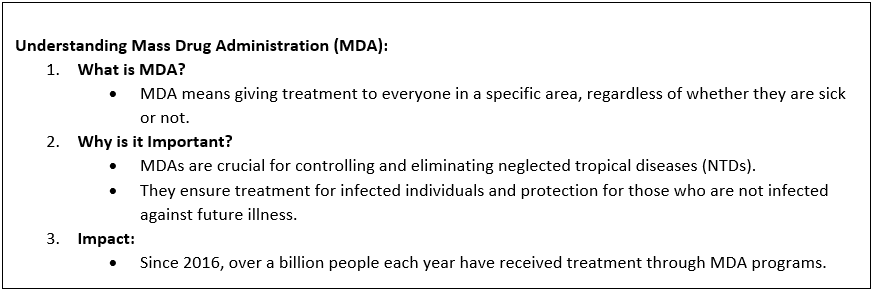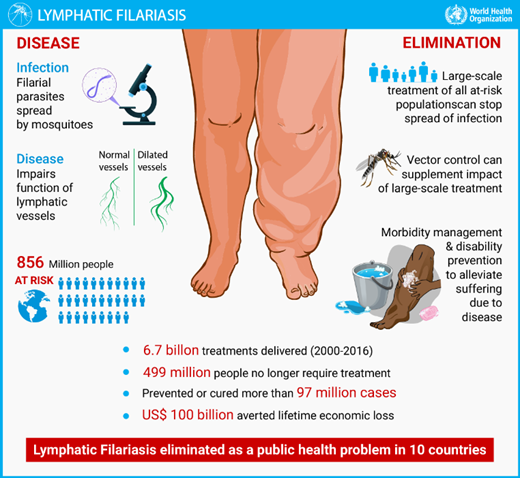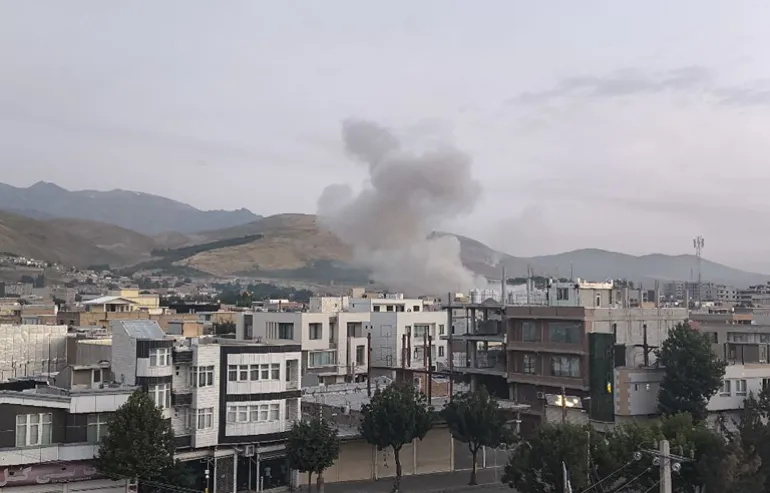- Courses
- GS Full Course 1 Year
- GS Full Course 2 Year
- GS Full Course 3 Year
- GS Full Course Till Selection
- Answer Alpha: Mains 2025 Mentorship
- MEP (Mains Enrichment Programme) Data, Facts
- Essay Target – 150+ Marks
- Online Program
- GS Recorded Course
- NCERT- First Ladder
- Polity
- Geography
- Economy
- Ancient, Medieval and Art & Culture AMAC
- Modern India, Post Independence & World History
- Environment
- Governance
- Science & Technology
- International Relations and Internal Security
- Disaster Management
- Ethics
- Current Affairs
- Indian Society and Social Issue
- CSAT
- 5 LAYERED ARJUNA Mentorship
- Public Administration Optional
- ABOUT US
- OUR TOPPERS
- TEST SERIES
- FREE STUDY MATERIAL
- VIDEOS
- CONTACT US
MASS DRUG ADMINISTRATION CAMPAIGN FOR LYMPHATIC FILARIASIS ELIMINATION
MASS DRUG ADMINISTRATION CAMPAIGN FOR LYMPHATIC FILARIASIS ELIMINATION
15-02-2024
In February 2024, The Union Minister of State for Health and Family Welfare has launched the first phase of the Bi-annual Nationwide Mass Drug Administration (MDA) campaign aimed at eliminating Lymphatic Filariasis (LF).
Campaign Objective
-
- The campaign seeks to check disease transmission by providing free preventive medications to residents living in areas affected by Lymphatic Filariasis (LF).
- It aims to cover 92 districts across 11 states during its initial phase.

Understanding Lymphatic Filariasis
-
Overview:

- Lymphatic filariasis is also known as elephantiasis
- It is a neglected tropical disease caused by filarial parasites transmitted through mosquitoes.
- It is a Vector-Borne Disease.
-
Lymphatic Filariasis Disease Incidences:
- Over 882 million people in 44 countries worldwide remain threatened by lymphatic filariasis and require preventive chemotherapy to stop the spread of this parasitic infection.
- India, particularly, faces a significant LF burden with 345 endemic districts across 20 states and union territories.
- In India, 75% of MDA districts belong to Bihar, Jharkhand, Uttar Pradesh, Odisha, and Telangana.
- LF affects more the urban poor and various rural segments of the population.
-
Impact:
- LF starts typically during childhood and persists into adulthood, leading to irreversible chronic health conditions.
- Besides physical health implications, LF contributes to stigma, mental distress, social marginalization, and economic hardships, increase poverty within affected communities.
-
Cause and Transmission:
-
Parasitic Infection:
- Lymphatic filariasis is caused by tiny parasites known as nematodes (roundworms) from the Filariodidea family. These worms are thread-like in shape.
- There are three main types of these filarial worms:
- Wuchereria bancrofti (responsible for around 90% of cases)
- Brugia malayi (causing most of the remaining cases) and
- Brugia timori
-
Transmission Cycle:
- Adult worms live in the lymphatic vessels, where they produce tiny larvae called microfilariae. These microfilariae circulate in the blood.
- Mosquitoes get infected when they bite an infected person, and they then transmit the larvae to humans when they bite, continuing the cycle of transmission.
-
-
Symptoms and Complications:
- Asymptomatic and Chronic Conditions: Most infections don't show any symptoms, but in chronic cases, it can lead to conditions like:
- Lymphoedema (swelling of limbs)
- Elephantiasis (thickening of skin and tissues)
- Hydrocele (swelling of the scrotum), causing physical and psychological distress.
- Acute Episodes: Chronic conditions often come with acute inflammatory episodes, resulting in severe symptoms and reduced productivity among those affected.
- Asymptomatic and Chronic Conditions: Most infections don't show any symptoms, but in chronic cases, it can lead to conditions like:
-
Approaches to Treatment and Prevention:
- Preventive Chemotherapy: The recommended strategy by the World Health Organization (WHO) is Mass Drug Administration (MDA) with annual doses of medicines to the at-risk population to eliminate lymphatic filariasis.
- MDA Regimens: Different drug regimens are suggested based on the presence of other filarial diseases in the area. The goal is to reduce the density of microfilariae and stop transmission.
- Morbidity Management: Surgery, hygiene measures, and medical care play vital roles in managing chronic symptoms and stopping disease progression.
- Vector Control: Strategies like mosquito control are essential supplements to reduce transmission and support preventive chemotherapy efforts.
-
WHO's Response and Objectives:
- Global Programme to Eliminate Lymphatic Filariasis (GPELF):
- GPELF, initiated in 2000, aims to eradicate lymphatic filariasis through preventive chemotherapy and managing associated morbidity.
- In the new NTD Road Map (2021–2030), GPELF aims for the following goals by 2020:
- Validation: The aim is for 80% of countries with endemic cases (58 in total) to confirm the elimination of the disease and maintain low infection rates after Mass Drug Administration (MDA).
- Surveillance: All countries with endemic cases (72 in total) should establish surveillance systems to prevent the resurgence of the disease.
- MDA Reduction: The objective is to reduce the population needing Mass Drug Administration (MDA) to zero.
- WHO’s strategy is based on 2 key components:
- stopping the spread of infection through large-scale annual treatment of all eligible people in an area or region where infection is present; and
- Alleviating the suffering caused by lymphatic filariasis through provision of the recommended essential package of care.
- India's Efforts:
- A Five-pronged Strategy: - India has introduced a new plan to speed up efforts to get rid of Lymphatic Filariasis. The Health and Family Welfare Minister launched a five-step strategy to eliminate the disease by 2027. The five pillars are as follows:
- Multi-drug administration (MDA) Campaign twice a year synchronized with National Deworming Day (10th Feb and 10th August)
- Early diagnosis and treatment; engagement of medical colleges for strengthening Morbidity management and disability (MMDP) services
- Integrated Vector Control with multi sectoral coordinated efforts
- For inter sectoral convergence with allied departments and ministries
- Leveraging existing digital platforms for LF and exploring alternate diagnostics
- India's Commitment: India is dedicated to eliminating Lymphatic Filariasis by 2027, three years ahead of the global target.
- A Team Effort: India is adopting this collaborative method through Jan Bhagidaari and the Whole of Government and Whole of Society approach.
- A Five-pronged Strategy: - India has introduced a new plan to speed up efforts to get rid of Lymphatic Filariasis. The Health and Family Welfare Minister launched a five-step strategy to eliminate the disease by 2027. The five pillars are as follows:
- Global Programme to Eliminate Lymphatic Filariasis (GPELF):



